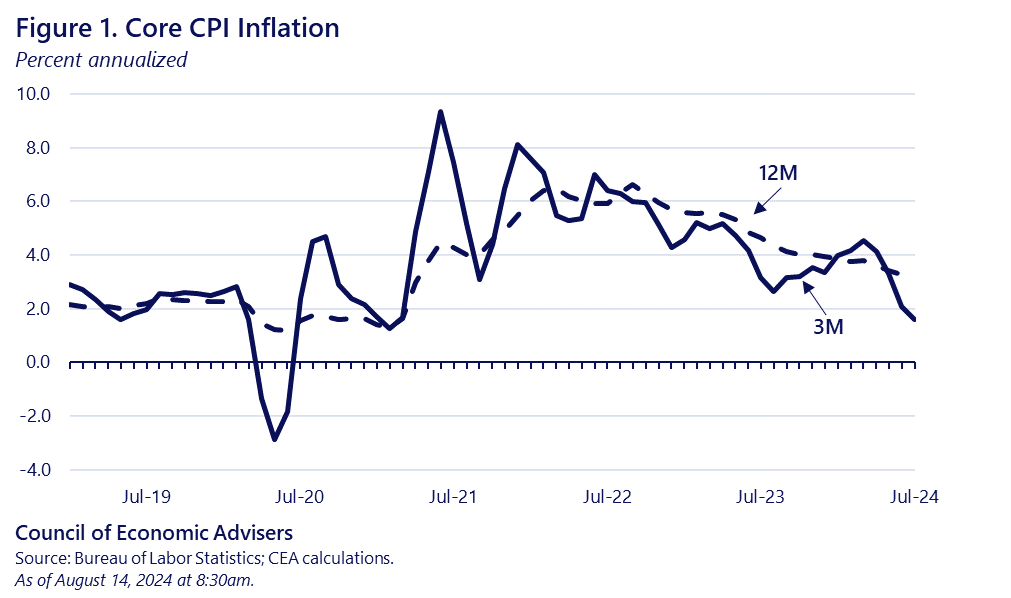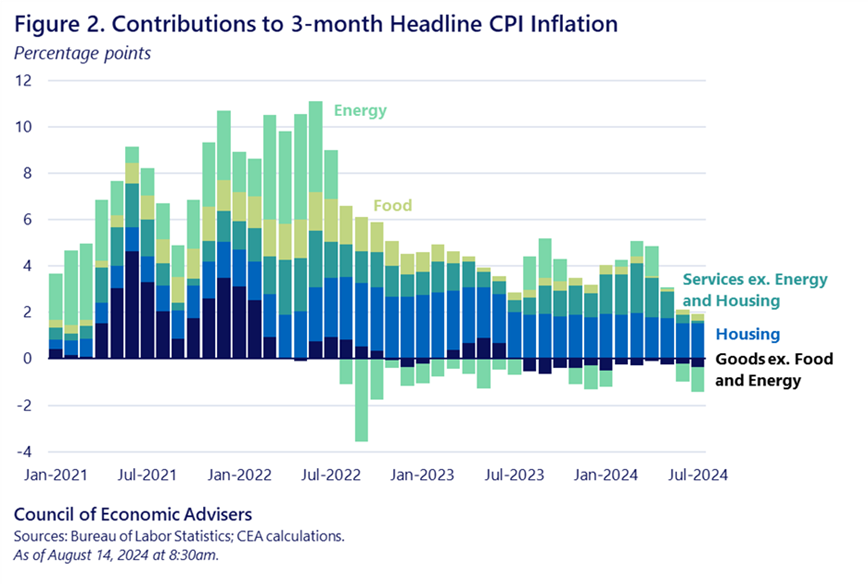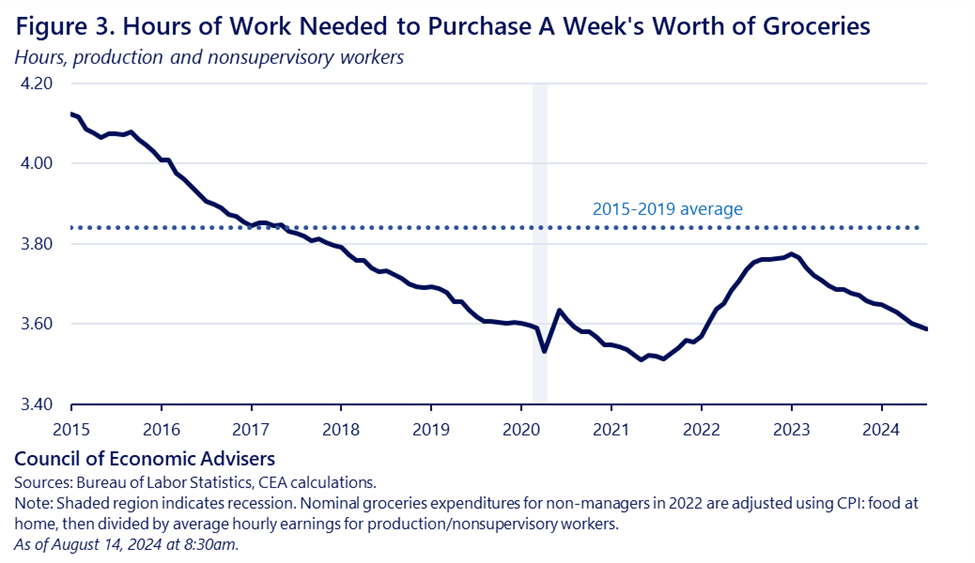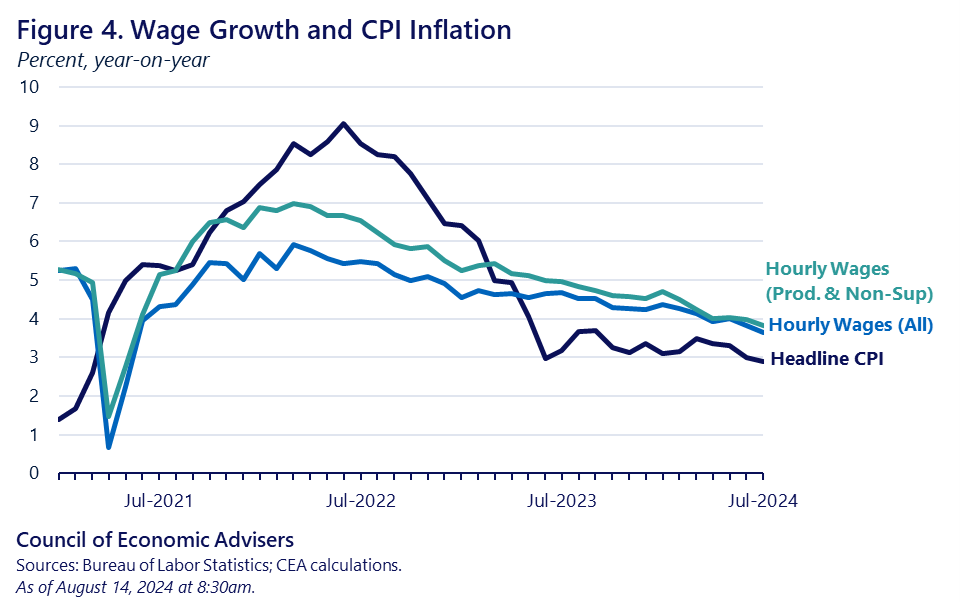July 2024 CPI Report
The Consumer Price Index increased 0.2% in July, coming in right at expectations. On a yearly basis, the CPI rose 2.9%, its lowest yearly growth rate since March of 2021 (and slightly below expectations of 3%). Similarly, core CPI inflation, which leaves out volatile food and energy prices, rose 0.2% in July, also at expectations. On a yearly basis, core CPI was up 3.2%, its lowest yearly rate since April of 2021.
For more details on a today’s release, check out CEA’s X thread.
As featured in a recent speech by CEA Chair Jared Bernstein, inflation is in the midst of a round-trip. Initially, inflation took off when strong consumer demand shifted quickly from in-person services towards goods at the same time that supply chains faced unprecedented, pandemic-induced disruptions. In fact, as shown in this new paper by Federal Reserve economists, inflation took off at about the same time and the same pace in most advanced economies (see their Figure 1). As supply chains unsnarled and demand cooled, disinflation took hold and, while its path has not been linear, inflation has been gradually drifting back down to pre-pandemic rates.
While the round-trip is not complete and there is more work to be done, data from the past year reveal a downward trend in inflation that continued in July. Figure 1 plots 12-month and 3-month annualized changes in core CPI. The 3-month measure captures more of inflation’s ups and downs since 2023, including the period during the first few months of this year when disinflation paused, but both series show that easing inflation is back on track.

The next figure sticks with the 3-month annualized growth rates, but breaks out inflation’s main components, including housing, energy, food, core services (services excluding housing and energy), and core goods (goods excluding food and energy). We discuss each in turn.
Core goods: The figure clearly shows the pandemic dynamics discussed above. Goods inflation was a major contributor to the rise in the CPI back in 2021, but been a negative contributor since July 2023. So far this year, core goods prices have decreased 0.9%.
Food: Food inflation was 0.2% in July and has also eased substantially from its peak. This is particularly the case for grocery prices, which ticked up 0.1% in July and 1.1% over the past year (groceries comprise about 8 percent of all purchases for the average household and 11 percent for those in the lowest-income quintile). Persistent cooling in grocery inflation marks the continuation of a welcome trend that CEA has been observing. The three-month annualized percent change in grocery prices has remained below headline CPI inflation since March 2023.
Restaurant prices have been considerably stickier, up 4.1% on a yearly basis. Even that rate, however, is less than half of the 8.8% inflation rate for restaurants in March of last year.
Energy: The price of energy, especially retail gas, has been another important source of disinflation, or in this case, deflation. Over the past year, the gas price included in the CPI is down 2.2%. Data from AAA show that over the past year, the average price for a gallon of gas fell from $3.85 to $3.44 as of August 13th, or $0.41 less per gallon. Note that over this same period, the average hourly wage for middle-wage workers went up (in nominal terms) from $29.03 to $30.14, or $1.09. In other words, an hour of work today buys more gas than it did a year ago due to the combination of both rising pay and falling gas prices.
Housing: Movements in housing prices have contributed less to inflation’s round-trip than the above categories, though they have helped. At its peak in February 2023, housing added 2.8 percentage points to three-month headline CPI inflation. By December 2023, this contribution was a full percentage point lower. After an uptick in the first quarter of this year, housing’s contribution to three-month annualized headline inflation has declined each month from April through July, and July saw the lowest contribution since October 2021.

While inflation’s continued descent from its roundtrip is obviously a positive development, it is not always apparent what all these numbers mean to households trying to make ends meet. As a concrete example of how these dynamics help in that endeavor, it is useful to turn back to grocery prices and also, as we did with retail gas above, add in the benefits of rising pay. The figure below shows the number of hours of work it takes for the average, middle-wage worker to afford a week’s worth of groceries.
Together, rising wages and falling grocery inflation have restored purchasing power for grocery shoppers to pre-pandemic levels. That is, it takes this worker the same amount of work to buy a bag of groceries as it did before the pandemic took hold and inflation took flight.

More broadly, as this last figure shows, yearly hourly wage growth has been outpacing price growth for 15 months, and for 17 months among middle-wage workers.

None of these favorable trends mean our work is over. Too many families still face prices that are too high, and we will continue our aggressive agenda to lower the costs of health care, prescription drugs, housing, child care, and many other sources of stress to family budgets. But the combination of easing inflation as it continues on its roundtrip, along with rising pay, is helping to lift families’ buying power, and we plan to continue to build on that progress.
